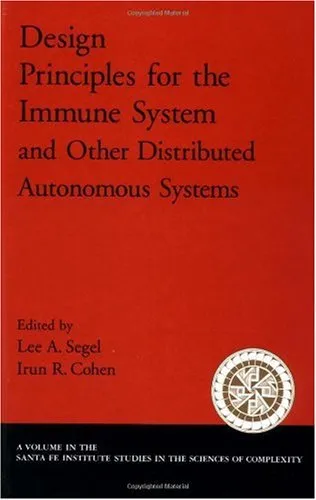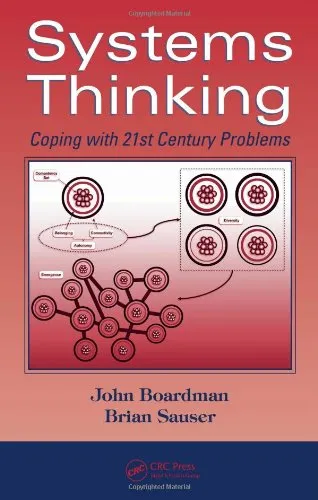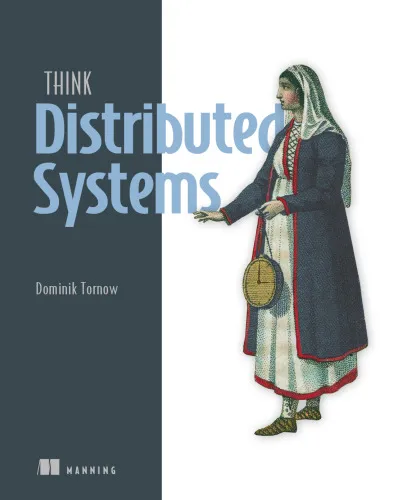Design Principles for the Immune System and Other Distributed Autonomous Systems (Santa Fe Institute Studies in the Sciences of Complexity Proceedings)
4.0
بر اساس نظر کاربران

شما میتونید سوالاتتون در باره کتاب رو از هوش مصنوعیش بعد از ورود بپرسید
هر دانلود یا پرسش از هوش مصنوعی 2 امتیاز لازم دارد، برای بدست آوردن امتیاز رایگان، به صفحه ی راهنمای امتیازات سر بزنید و یک سری کار ارزشمند انجام بدینکتاب های مرتبط:
معرفی کتاب "Design Principles for the Immune System and Other Distributed Autonomous Systems"
کتاب "Design Principles for the Immune System and Other Distributed Autonomous Systems" اثری است از لی آ. سیگل و ایرون آر. کوهن که به بررسی اصول طراحی در سیستمهای پیچیده توزیعشده میپردازد. این اثر با تمرکز ویژه بر سیستم ایمنی بدن، از رویکردهای چندرشتهای برای توضیح چگونگی عملکرد سیستمهای خودمختار استفاده میکند. کتاب بخشی از مجموعه مطالعات موسسه سانتافه درباره پیچیدگی است و در تحقیق درباره نظامهای زیستی و فناورانه پیشرو محسوب میشود.
خلاصهای از کتاب
این کتاب یک تحلیل عمیق از اصول سیستمهای توزیعشده، مانند سیستم ایمنی بدن ارائه میدهد. سیستم ایمنی به عنوان یک نمونه شاخص از یک نظام خودمختار توزیعشده مطرح میشود که دارای اجزائی است که بدون نیاز به مرکزیت خاصی عمل میکنند. نویسندگان توضیح میدهند که چگونه تعاملات محلی بین اجزا، نتایج کلی و جهانی ایجاد میکنند. این کتاب بر اساس مفاهیم توزیعشدگی، عدم تمرکز، دینامیک سیستمهای غیرخطی و تطبیقپذیری نوشته شده و از مثالهای بیولوژیکی برای تبیین رفتارهای پیچیده استفاده میکند. علاوه بر این، مفاهیمی همچون feedback loops، homeostasis و robustness به شیوهای روشن و کاربردی ارائه میشوند.
نکات کلیدی کتاب
- تعریف اصول کلی سیستمهای خودمختار و توزیعشده.
- تحلیل قابلیتهای سیستم ایمنی در شناسایی تهدیدها و پاسخ به آنها.
- چگونگی استفاده از مفاهیم سیستم ایمنی برای طراحی الگوریتمهای شبکههای کامپیوتری و رباتیک.
- نقش تعاملات محلی در ایجاد رفتارهای کلان.
- توضیح چگونگی سازگاری سیستم ایمنی با تهدیدات جدید و ایجاد حافظهای ماندگار.
نقل قولهای معروف از کتاب
“The immune system is not a centralized intelligence but rather a distributed network that thrives on diversity and redundancy.”
“Understanding distributed systems like the immune system can inspire revolutionary designs in artificial intelligence and robotics.”
“Emergence in complex systems depends on the interplay between order and randomness.”
چرا این کتاب اهمیت دارد؟
این کتاب برای دانشمندان، مهندسان و علاقهمندان به علوم پیچیدگی از اهمیت ویژهای برخوردار است. از یک طرف، با توضیح اصول عملکرد سیستم ایمنی بدن، درک عمیقتری از زیستشناسی مدرن ارائه میدهد و از سوی دیگر، نقشه راهی برای طراحی سیستمهای هوش مصنوعی و رباتیک توزیعشده فراهم میکند. همچنین، این کتاب تأکید میکند که بسیاری از چالشهای موجود در طراحی سیستمهای خودمختار با الهام از طبیعت و اصول عملکرد سیستم ایمنی قابل حل هستند. از این رو، اثر حاضر درکهای علمی و کاربردهای مهندسی را به شکلی یکپارچه ترکیب میکند.
Introduction to "Design Principles for the Immune System and Other Distributed Autonomous Systems"
The book "Design Principles for the Immune System and Other Distributed Autonomous Systems" by Lee A. Segel and Irun R. Cohen represents a remarkable exploration of the intricate principles governing distributed systems in both biological and computational contexts. By drawing analogies between the immune system and other decentralized systems, this work bridges science, mathematics, and technology in a profound and intellectually stimulating way.
This book is part of the Santa Fe Institute Studies in the Sciences of Complexity series, which focuses on multidisciplinary approaches to understanding complex systems. Within its pages, the reader will uncover a wealth of insight into both natural and artificial distributed systems, with a special focus on the immune system—a highly sophisticated and self-regulating network capable of managing massive complexity with minimal centralized control.
As a foundational text for researchers and enthusiasts of systems theory and computational biology, the book discusses key aspects of decentralized systems, their design principles, and the parallels between biological entities and modern artificial intelligence systems. The immune system is not merely treated as a biological mechanism but as a paradigm of efficient distributed problem-solving.
Detailed Summary of the Book
At its core, the book provides an in-depth discussion of how distributed autonomous systems function and evolve. The biological immune system serves as a central case study for the theoretical framework presented. The authors meticulously analyze its decentralized architecture, exploring how it performs tasks such as pathogen detection, self-regulation, and memory storage without relying on centralized control.
The text delves into the following themes:
- The balance between self-organization and programmed functions in distributed systems.
- The immune system's strategies for maintaining stability amidst external perturbations.
- Design principles for artificial autonomous systems inspired by biological models.
- The trade-offs between redundancy, efficiency, and adaptability in decentralized environments.
In addition to theoretical explorations, the book considers practical implications for designing efficient and robust distributed systems in fields such as computational networks, robotics, and artificial intelligence. Each chapter builds on the previous one, leading to a comprehensive portrait of how complex systems operate at multiple levels of abstraction.
Key Takeaways
One of the book’s most compelling aspects is its ability to draw lessons from biology to inform the design of technological systems. Here are some of the key takeaways:
- Distributed systems thrive on decentralized control, where global behaviors emerge from local interactions.
- Redundancy is a critical feature of robust systems, ensuring survival and adaptability in the face of uncertain environments.
- Systems that can "learn" from their past interactions (e.g., immunological memory) provide a framework for adaptive problem-solving.
- Understanding the principles of the immune system can inspire the next generation of algorithms and machine learning models.
- Balancing competition and cooperation within a system fosters healthier, more sustainable dynamics.
Famous Quotes from the Book
The book contains many thought-provoking observations from Lee A. Segel and Irun R. Cohen. Here are a few noteworthy quotes:
"The immune system is less a mechanism and more a distributed, decision-making process that continuously adapts to a changing environment."
"Complexity thrives on simplicity—this paradox is central to both natural and artificial distributed systems."
"True intelligence emerges when diverse components cooperate and compete without a predefined blueprint."
Why This Book Matters
"Design Principles for the Immune System and Other Distributed Autonomous Systems" matters because it occupies both theoretical and practical niches in our understanding of complexity science. It is not just another book about distributed systems or immunology—it is a work that transcends disciplinary boundaries to offer solutions to some of our biggest design challenges.
In an era where artificial intelligence and autonomous robotics are rapidly evolving, understanding how to design systems that can operate efficiently without central oversight is more important than ever. The immune system, with its unparalleled ability to detect, adapt, and respond to changing environments, provides a roadmap that can fundamentally transform how we approach problems in technology, engineering, and life sciences.
Whether you are a biologist, a computer scientist, or someone interested in the philosophy of design, this book will inspire you to reconsider how we think about intelligence, adaptation, and resilience. It brings clarity to the intricate dance between order and disorder, offering insights that are as timeless as they are prescient.
دانلود رایگان مستقیم
شما میتونید سوالاتتون در باره کتاب رو از هوش مصنوعیش بعد از ورود بپرسید
دسترسی به کتابها از طریق پلتفرمهای قانونی و کتابخانههای عمومی نه تنها از حقوق نویسندگان و ناشران حمایت میکند، بلکه به پایداری فرهنگ کتابخوانی نیز کمک میرساند. پیش از دانلود، لحظهای به بررسی این گزینهها فکر کنید.
این کتاب رو در پلتفرم های دیگه ببینید
WorldCat به شما کمک میکنه تا کتاب ها رو در کتابخانه های سراسر دنیا پیدا کنید
امتیازها، نظرات تخصصی و صحبت ها درباره کتاب را در Goodreads ببینید
کتابهای کمیاب یا دست دوم را در AbeBooks پیدا کنید و بخرید
1200
بازدید4.0
امتیاز0
نظر98%
رضایتنظرات:
4.0
بر اساس 0 نظر کاربران
Questions & Answers
Ask questions about this book or help others by answering
No questions yet. Be the first to ask!















